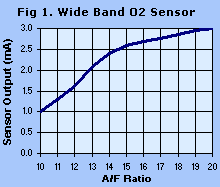The RENIX HEGO sensor is different (but he's wrong as to why.)
The typical "Titania" HEGO sensor used in most vehicles generates a variable voltage, between 0 and +1VDC, with +.5VDC being a "normal" reading, or "lambda = 1." Under .5VDC, as I recall, indicates a "lean" condition, and over .5VDC indicates a "rich" condition.
The "Zirconia" sensor used in RENIX (and limited other vehicles,) is a "variable resistance" which is fed a +5VDC "reference" voltage by the ECU. The Zirconia HEGO sensor then works as a voltage divider, and a return signal of +2.5VDC is "normal" - with lower voltages indicating "lean" and higher indicating "rich" (again, as I recall. I may have those voltage signals reversed, but the idea is still there.)
This is why you see a lot of posts by me telling people not to use "universal" HEGO sensors in their RENIX rigs - the universal is a Titania type, and is incompatible with the RENIX system. Since the Zirconia only costs a few bucks more, generally, why not just get one that works?
The only HEGO sensors I've seen run anywhere near $500 (and they're more like $300!) are the "Wideband" HEGO sensors used with AFR meters. The conventional HEGO sensor responds on a "knuckle" - you get a linear signal within a very narrow range of AFR (say, 14.0:1 to 15.5:1) and then it's just a flat "rich" or "lean" beyond that. These are typically referred to as "narrowband" or "knuckle" HEGO sensors - I usually call them NHEGO (Narrowband Heated Exhaust Gas Oxygen) when I'm talking about both of them.
Wideband (WHEGO) sensors will give a quantifiable response from, say, 5.0:1 to 25.5:1 AFR, and can therefore quantify just how "rich" or "lean" an engine is running. They're typically used as tuning tools.
Side note - you can change a HEGO sensor yourself on RENIX in about a half-hour - use a HEGO sensor socket if you have one, a 7/8" wrench if you don't. Pull with the engine still warm, it will be easier.
Get a replacement from Borg/Warner, ACDelco, or Bosch - I've had good luck with all three. Make sure there is never-seez on the threads - apply it if not present. Use a socket to reinstall, torque to 21 pound-feet.
Connect the electrics, and have a beer - you're done!


